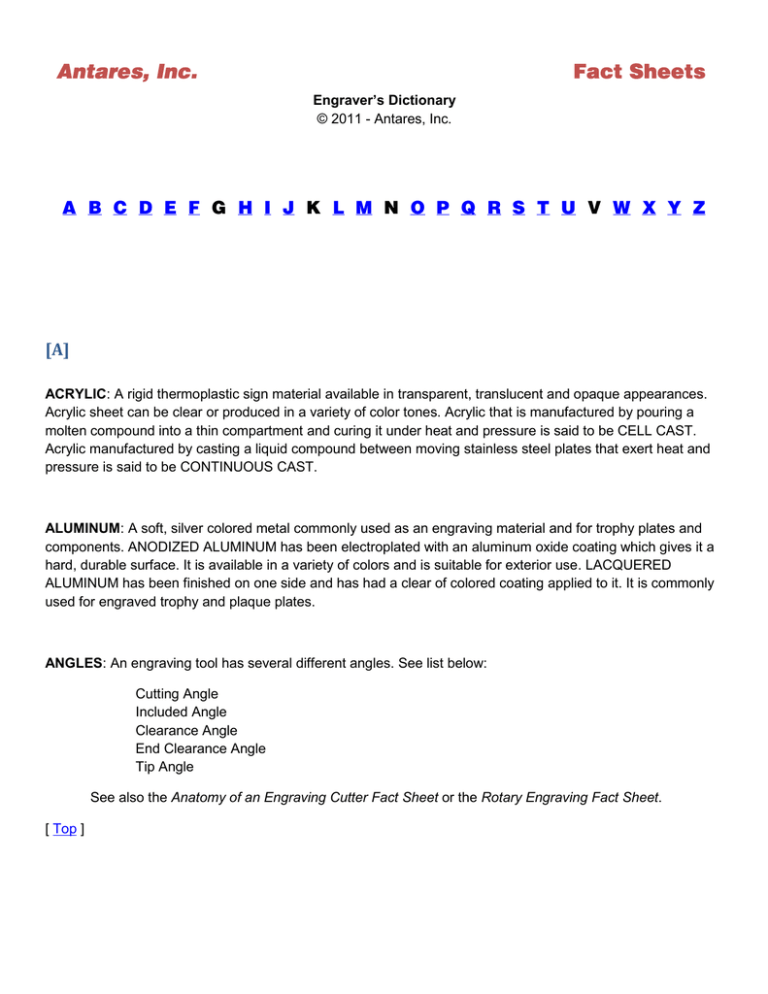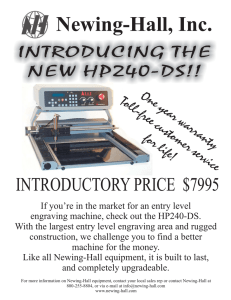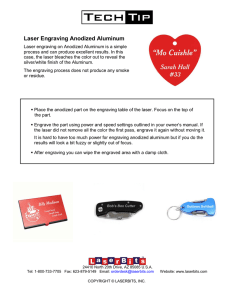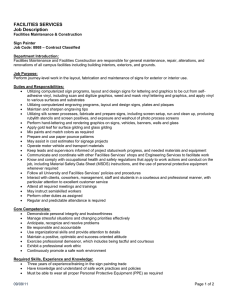Fact Sheet - Antares, Inc.
advertisement

Engraver’s Dictionary © 2011 - Antares, Inc. [A] ACRYLIC: A rigid thermoplastic sign material available in transparent, translucent and opaque appearances. Acrylic sheet can be clear or produced in a variety of color tones. Acrylic that is manufactured by pouring a molten compound into a thin compartment and curing it under heat and pressure is said to be CELL CAST. Acrylic manufactured by casting a liquid compound between moving stainless steel plates that exert heat and pressure is said to be CONTINUOUS CAST. ALUMINUM: A soft, silver colored metal commonly used as an engraving material and for trophy plates and components. ANODIZED ALUMINUM has been electroplated with an aluminum oxide coating which gives it a hard, durable surface. It is available in a variety of colors and is suitable for exterior use. LACQUERED ALUMINUM has been finished on one side and has had a clear of colored coating applied to it. It is commonly used for engraved trophy and plaque plates. ANGLES: An engraving tool has several different angles. See list below: Cutting Angle Included Angle Clearance Angle End Clearance Angle Tip Angle See also the Anatomy of an Engraving Cutter Fact Sheet or the Rotary Engraving Fact Sheet. [ Top ] [B] BAKELITE: A rigid plastic used as an engraving material or as a matrix material for making rubber stamps. It is commonly called phenolic or melamine. BEVEL: A sloped edge that runs from the top to the bottom of a nameplate's edges providing a bordering effect. BRASS: A metal alloy made up of copper and zinc, commonly used as an engraving material or in the manufacture of engravable gift items. Most often recognized by its natural yellow-gold color, brass is also available in a variety of lacquered colors. Brass that contains a higher lead content is referred to a "leaded" brass or ENGRAVERS BRASS. This is softer, easier to machine and is recommended for rotary engraving. TROPHY BRASS is harder and is generally intended for diamond engraving. BOTTOM-LOADING CUTTERS: Cutters inserted into the bottom of the spindle and are held in place by a set screw or a collet. BURNISHING: A method of engraving on metal that allows for wider line widths than diamond engraving without having to rout deeply into the material. It is a surface technique generally done on coated metals such as lacquered brass. A faceted, rotating tool called a BURNISHER removes the lacquer coating and exposes the bare metal. For more information, see: Burnishing Fact Sheet [ Top ] [C] CAMERA-READY ARTWORK: Black and white artwork that contains no imperfections or irregularities and is ready to be reproduced. This type of artwork provides the best results when reproducing imagery for hot stamping, sublimation, screen printing, digitizing or scanning. CAP LAYER: The top or outer surface layer of engraving plastic. CARBIDE: An extremely hard material manufactured primarily from tungsten and cobalt. Its hardness and abrasion resistance qualities make it suitable for a variety of cutting tool and wear part applications. Carbide is generally recommended for the majority of engraving cutter applications due to its toughness and long life characteristics. CENTERING: To position something in such a way that it is the same distance from all sides of an object: for example, centering copy or text on a plaque, or centering a name on a nameplate. CHAMFER: A sloped surface that starts at the top of the material's edge and ends part way down the side rather than at the bottom. The bordering appearance is similar to that which is produced by a bevel. CHATTER: The vibration produced by a rotating engraving cutter. Generally caused by defective cutters or spindles and results in rough cuts and finishes in the work. Also caused by bad spindle bearings. CLEARANCE ANGLE: Refers to the angle of the cutting edge with respect to the face of the cutter. This angle allows for chip clearance, determines how fine the cutting edge is and is selected based on material properties. CO-EXTRUDED ENGRAVING PLASTIC: A flexible engraving material produced by simultaneously merging two plastics together during the manufacturing process. One plastic forms the cap surface, the other the core. COLLET: Device which holds collet cutters in the spindle. COLLET CUTTER: A cutter that is typically shorter than a standard cutter. Collet cutters are inserted into the bottom of the spindle and held in place by a collet. COLOR-FILLING: The method of filling deeply cut, rotary engraved characters with ink, paint, or paste to odd color or contrast. Also known as PAINT FILLING. For more information, go to: Color Fill Fact Sheet CONICAL CUTTERS: Those having an angled cutting edge which produce a "V" shaped cut. CORE: The back of 2-ply engraving material or the center of 3-ply engraving materials. The core produces the contrasting color to the cap surface. CUTTERS: An all-inclusive term used to describe the rotating cutting tools used in the engraving operation. Cutters can be manufactured from high speed steel or carbide and are available in a variety of configurations for specific applications. Typically, engraving cutters are single-flute tools, which means they have only one cutting edge. See also: Conical Cutters Quarter-Round Cutters Top-Loading Cutters Half-Round Cutters Parallel Cutters Bottom-Loading Cutters CUTTER GRINDER: A machine used to sharpen and tip engraving cutters. CUTTER SHANK: The main cylindrical body of an engraving tool. CUTTING ANGLE: The angle formed between the cutter's axis of rotation and its cutting edge and determines the shape of the "V" groove produced by conical cutters. CUTTING FEED: The speed at which the cutter penetrates the material being engraved is called the "down feed." The speed at which the cutter moves from one point to another during engraving is called the "lateral feed." CUTTING FLUID (OIL): Liquid or gaseous material used to cool or lubricate the material or the cutting tool when rotary engraving or machining some surfaces. CUTTING SPEED: The speed with which a rotary spindle turns while it is engraving. The rpm of a spindle. [ Top ] [D] DEPTH NOSE (DEPTH REGULATOR NOSE): A metal or plastic assembly mounted on the bottom of the spindle and used to control the depth of the cut when rotary engraving. DIAMOND DRAG: A method of engraving metals using a non-rotating diamond tipped tool called a "DIAMOND GRAVER." As downward spindle pressure is applied, the point of the graver penetrates the surface of the material and scribes a fine line as the character is formed. This type of engraving is sometimes referred to as "diamond engraving" or "scratch" engraving. DIAMOND GRAVER: The tool used for diamond engraving. It consists of a steel shank with a diamond set in one end that is ground and lapped to a conical point it is a non-rotating tool that is used without a depth nose. [ Top ] [E] END CLEARANCE ANGLE: The end clearance angle is the angle on the back side of the tip angle to provide clearance. END MILL: Usually a multi-fluted cutting tool generally used in machining operations. While some have straight flutes, most are spiraled and are used for heavy cuts at low speeds. ENGRAVING: The art of cutting or carving grooves or characters into a surface. The more common forms are hand engraving, mechanical engraving (pantographs, computer engravers, etc.) and a variety of photographic and chemical etching processes. For more information, see: Rotary Engraving Fact Sheet [ Top ] [F] FINDINGS: Badge and jewelry fasteners such as pins, clips and clasps. FLAME POLISHING: A technique for smoothing and polishing the edges of a material using an open flame. FLEXIBLE ENGRAVING MATERIAL: A soft, pliable, bendable thermoplastic material that is easy to cut and engrave. [ Top ] [H] HALF-ROUND CUTTERS: Are made from blanks that have been "split" or "halved" approximately on center through a grinding process. This tool has a cross-section that is half of a cylinder and is the choice for most engraving cutter applications. HAND-ENGRAVING: The art of engraving done freehand using specially shaped and contoured hand-held tools and requiring a considerable degree of artistic talent. HIGH SPEED STEEL: Is a term used to describe a wide range of steel alloys used for cutting tools. These materials incorporate varying amounts of many different elements (Tungsten, Molybdenum. Cobalt, etc.) to produce specific hardness and cutting characteristics. High Speed Steel tools are more resilient than those made from carbide; however they do not possess the hardness or abrasion resistance. [ Top ] [I] INCLUDED ANGLE: The included angle is double the cutting angle. See also: Cutting Angle [ Top ] [J] JUSTIFICATION: The horizontal positioning of text relevant to the margins. Text can be Left Justified, Center Justified, Right Justified, or Fully Justified. Center and Full Justification are the most frequently used in the awards industry. [ Top ] [L] LACQUER: A clear or colored coating applied to the finished surface of many engraving metals. LAMINATE (ENGRAVING STOCK): A material manufactured by fusing two or more layers together to form one solid sheet. LASER ENGRAVING: Engraving using a high-energy light beam that vaporizes the material being engraved. LEGEND PLATE: A small tag, often times engraved, that is affixed to a machine or other object that contains instructions, warnings or mechanical data. [ Top ] [M] METHYLENE CHLORIDE: A watery glue used to bond plastics together, or attach plastic-backed findings to badges. Some common brand names are Rezn-Bond and Liquid Bond. MICROGRAIN CARBIDE: Is a hybrid of conventional carbide that incorporates a smaller particle size. This finer structure results in a material that is considerably stronger and tougher than conventional carbide grades which equates to longer tool life. MICROSURFACE ENGRAVING STOCK: Flexible engraving plastic having a very thin cap surface that has been hot-stamped to a core material. [ Top ] [O] OXIDIZER: A mild chemical solution that causes un-coated areas of brass and aluminum to turn black. For more information, go to: Color Fill Fact Sheet [ Top ] [P] PANTOGRAPH: For many years the mainstay of the engraving industry and still in common usage serving a vital role. Pantograph is on all-inclusive term that is used to describe a wide variety of machines ranging from very small two dimensional, fixed ratio non-motorized machines, to large, free standing, three dimensional, variable ratio ones. Regardless of their size or complexity all pantographs basically operate in the same manner, i.e. tracing a template with a stylus attached to the arms of the machine and, through a reduction ratio produces a mark on or into the surface of the material being engraved. PARALLEL CUTTERS: Those with a cutting edge that is parallel to the shank of the tool and produce a cut with straight edges. PHENOLIC: A rigid, brittle laminated plastic. PHOTOENGRAVING: A chemical etching process used on magnesium and zinc. Commonly used for making rubber stamp dies or hot-stamping dies. PLY: An individual layer of a laminated material. PANTONE MATCHING SYSTEM (PMS): A standard of the graphics industry for color matching specific colors and mixing inks. PROFILING: The technique of cutting through a piece of material using a rotary engraving cutter. This method of engraving is commonly used for making badge blanks, cutting out irregular shapes or making cut-outs in control panels. [ Top ] [Q] QUARTER-ROUND CUTTERS: Half-round tools that have a secondary split at 90 degrees to the original flat producing a tool that has a cross-section that is one quarter of a cylinder. [ Top ] [R] ROTARY ENGRAVING: Engraving that is done with a rotating tool or cutter in a motorized spindle. The process is similar to routing and is used to produce cuts of specified widths and depths in a wide variety of materials. [ Top ] [S] SCORE: To cut the surface of a piece of plastic engraving material deeply enough so that the material can be broken along the cut line. This process can be used for cutting smaller plates from larger sheets of engraving plastic. SHEAR: A cutting device that cuts material through the closure of two blades. In our industry shears are normally purchased for cutting metal or plastic. Standard metal shears (the cutting edge of the upper blade is generally ground at an angle of eight degrees to the blade's edge) are capable of cutting brass up to .025" thick or aluminum up to .040" thick. Standard plastic shears (with the upper blade ground with a knife-like edge having on angle of twenty degrees measured from the face of the blade) can cut flexible engraving plastic up to 3/32" thick. For more information, see: Shear Fact Sheet SOLVENT WELDING: Using chemical solvents such as methylene chloride to glue plastics together. SPINDLE: The part of an engraving machine that holds the cutter. STRIP HEATING: Heating a piece of plastic along a narrow line in order to bend it at that line. Used for making self-standing counter signs or nameplates and over-the-pocket badges. [ Top ] [T] TIP-OFF: Is the flat at the tip of the cutter. Also the tip width of the cutter. The tip off (or tip width) determines the width of the bottom of the cut. TOP-LOADING CUTTERS: Cutters that are inserted into the spindle from the top and are typically held in place by means of a threaded knob. [ Top ] [U] UV RESISTANT: Being resistant to ultra violet (UV) light or sunlight. UV light, or sunlight, will cause nonresistant materials and surfaces to fade or discolor. [ Top ] [W] WORKING RANGE: The maximum area that can be engraved in one setup on an engraving machine. [ Top ] [X] X-AXIS: The left-to-right or horizontal movement of the engraving spindle. [ Top ] [Y] Y-AXIS: The front-to-back movement of the engraving spindle. [ Top ] [Z] Z-AXIS: The vertical or up & down movement of the engraving spindle. [ Top ]



